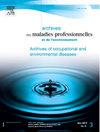Facteurs liés au maintien dans l’emploi des hémodialysés : étude auprès de 31 travailleurs hémodialysés à Franceville (Gabon)
IF 0.3
4区 医学
Q4 PUBLIC, ENVIRONMENTAL & OCCUPATIONAL HEALTH
Archives Des Maladies Professionnelles Et De L Environnement
Pub Date : 2025-03-20
DOI:10.1016/j.admp.2025.102830
引用次数: 0
Abstract
Introduction
Les travailleurs hémodialysés rencontrent des difficultés pour maintenir un emploi durable. Leur état de santé et les modalités de prise en charge de la maladie sont des facteurs associés à ces difficultés. Cette étude a été menée afin d’identifier les facteurs associés au maintien dans l’emploi des travailleurs hémodialysés à Franceville.
Patients et méthode
L’étude était transversale, quantitative et analytique réalisée du 01 mars 2023 au 02 mars 2024, au centre d’hémodialyse de Franceville au Gabon. Tous les malades hémodialysés justifiant de la qualité de travailleur permanent et ayant accepté librement de participer à l’étude ont été inclus. L’échantillonnage était aléatoire simple. La collecte des données a été effectuée à l’aide d’un questionnaire que nous avons administré aux participants pendant les séances d’interviews. L’étude statistique a été réalisée à l’aide du logiciel R version 4.3.3. Les facteurs associés au maintien à l’emploi ont été déterminés par un modèle de régression logistique au seuil de signification 5 %.
Résultats
Nous avons inclus 31 hémodialysés, dont 21 hommes et 10 femmes. L’âge moyen était de 45 ans ± 11,5 ans. Les ouvriers étaient surreprésentés dans l’échantillon (68 %). La majorité des participants travaillait en sous-traitance (58,1 %). La durée moyenne de la dialyse était de 13,9 ± 16,1 mois [1–72 mois]. Les comorbidités étaient présentes chez 25 participants (80,6 %). La régression logistique a identifié 2 facteurs de maintien à l’emploi : le type de contrat de travail (OR : 9,60 [1,41–194,26], p = 0,048) et l’accompagnement de l’entreprise (OR : 17,14 [2,47–351,84], p = 0,014).
Conclusion
L’étude a permis de révéler que le type de contrat de travail et l’accompagnement par les entreprises, contribuent au maintien de l’emploi des travailleurs hémodialysés du centre d’hémodialyse de Franceville. Elle suscite un meilleur accompagnement des hémodialysés de la part de l’état et des entreprises en milieu de travail.
Introduction
Haemodialysis patients find it difficult to keep a job in the long term. Their health status and the way the disease is managed are factors associated with these difficulties. This study was conducted to identify the factors associated with job retention among haemodialysis patients in Franceville.
Patients and method
The study was a cross-sectional, quantitative and analytical study conducted from 01 March 2023 to 02 March 2024 at the Franceville haemodialysis centre in Gabon. All haemodialysis patients with permanent worker status who freely agreed to participate in the study were included. Sampling was simple random. Data were collected using a questionnaire that we administered to the participants during the interview sessions. The statistical study was carried out using R software version 4.3.3. The factors associated with job retention were determined using a logistic regression model at the 5% significance level.
Results
We included 31 haemodialysis patients, 21 men and 10 women. The mean age was 45 ± 11.5 years. Manual workers were over-represented in the sample (68%). The majority of participants worked as subcontractors (58.1%). The mean duration of dialysis was 13.9 ± 16.1 months [1–72 months]. Comorbidities were present in 25 participants (80.6%). Logistic regression identified 2 factors for job retention: type of employment contract (OR: 9.60 [1.41–194.26], P = 0.048) and company support (OR: 17.14 [2.47–351.84], P = 0.014).
Conclusion
The study revealed that the type of employment contract and the support provided by companies help to maintain employment for haemodialysis workers at the Franceville haemodialysis centre. It calls for better support for haemodialysis patients from the government and companies in the workplace.
维持血液透析者就业的因素:对弗朗斯维尔(加蓬)31名血液透析者的研究
血液透析工人在维持可持续就业方面面临挑战。他们的健康状况和疾病管理是与这些困难有关的因素。这项研究的目的是确定与弗朗斯维尔血透析工人继续就业有关的因素。这项横断面定量分析研究于2023年3月1日至2024年3月2日在加蓬弗朗斯维尔血液透析中心进行。所有血液透析患者都包括在内,他们证明自己是一名长期工人,并自愿参与这项研究。抽样是简单的随机。数据收集是通过一份问卷完成的,我们在访谈过程中发给参与者。统计研究使用R软件4.3.3进行。与维持就业相关的因素是通过5%显著阈值的物流回归模型确定的。结果包括31名血液透析患者,其中男性21人,女性10人。平均年龄为45±11.5岁,工人在样本中所占比例过高(68%)。大多数参与者从事分包工作(58.1%)。平均透析时间为13.9±16.1个月[1 - 72个月]。25名参与者(80.6%)共病。物流回归确定了两个维持就业的因素:雇佣合同类型(OR: 9.60 [1,41 - 194.26], p = 0.048)和企业支持(OR: 17.14 [2,47 - 351.84], p = 0.014)。结论研究表明,雇佣合同的类型和公司的支持有助于维持弗朗斯维尔血液透析中心的血液透析工人的就业。它鼓励国家和企业在工作场所更好地支持血液透析患者。血液透析患者发现很难长期保持工作。他们的健康状况和疾病的管理方式是与这些困难有关的因素。这项研究的目的是确定与弗朗斯维尔血液透析患者的工作保留相关的因素。该研究是一项于2023年3月1日至2024年3月2日在加蓬弗朗斯维尔血液透析中心进行的横断面、定量和分析研究。所有自愿同意参与研究的永久工人身份的血液透析患者都包括在内。采样是简单的随机。数据是通过我们在访谈期间分发给参与者的问卷收集的。统计研究是使用R软件版本4.3.3进行的。在5%的显著性水平上,使用物流回归模型确定了与工作保留相关的因素。结果包括31例血液透析患者,21名男性和10名女性。平均年龄为45±11.5岁。在样本中,体力劳动者的比例过高(68%)。大多数参与者是分包商(58.1%)。平均透析时间为13.9±16.1个月[1 - 72个月]。25名参与者(80.6%)有共生体。物流回归确定了影响工作留用的两个因素:就业合同类型(OR: 9.60 [1.41 - 194.26], P = 0.048)和公司支持(OR: 17.14 [2.47 - 351.84], P = 0.014)。结论研究表明,就业合同的类型和公司提供的支持有助于维持弗朗斯维尔血液透析中心血液透析工人的就业。它呼吁政府和工作场所的公司为血液透析患者提供更好的支持。
本文章由计算机程序翻译,如有差异,请以英文原文为准。
求助全文
约1分钟内获得全文
求助全文
来源期刊

Archives Des Maladies Professionnelles Et De L Environnement
医学-公共卫生、环境卫生与职业卫生
CiteScore
0.40
自引率
50.00%
发文量
185
审稿时长
50 days
期刊介绍:
The Archives of Occupational and Environmental Diseases (Archives des maladies professionnelles et de l''environnement) publish scientific original articles in the form of memoirs, developments and general health reviews. The journal is a reliable source of information, which lets you gain additional knowledge or update your knowledge of basic or original issues.
The section Continuous professional development focuses on a major issue and gives you the tools to optimize your practice. The content is divided in 3 parts: Reading Test, Answer to the Reading Test and Scientific Press Review, which let you share the analysis, by the editorial board, of articles from major English-language journals.
The section Legal Environment discusses an environmental culture. The section Letter to the editor keeps you informed about the press review; the Legislation, with the latest regulations published in the Official Journal; and the agenda of the meetings and the Congress, the questions–answers, etc. The Archives of Occupational and Environmental Diseases include all the scientific communications of the French occupational health societies, of which they are the official journal.
 求助内容:
求助内容: 应助结果提醒方式:
应助结果提醒方式:


